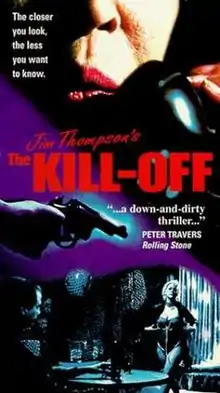The Kill-Off
The Kill-Off is a 1990 American drama film written and directed by Maggie Greenwald, based on a 1957 novel of the same name by Jim Thompson. It was an independent film, produced by Lydia Dean Pilcher and shot by Declan Quinn in his film debut.[1]
| The Kill-Off | |
|---|---|
 Video Cover | |
| Directed by | Maggie Greenwald |
| Produced by | Lydia Dean Pilcher |
| Screenplay by | Maggie Greenwald |
| Based on | The Kill-Off by Jim Thompson |
| Starring | Cathy Haase Loretta Gross Andrew Lee Barrett |
| Music by | Evan Lurie |
| Cinematography | Declan Quinn |
| Edited by | James Y. Kwei |
Production company | Filmworld International Productions Palace Pictures |
| Distributed by | Cabriolet Films |
Release date |
|
Running time | 110 minutes |
| Country | United States |
| Language | English |
Plot
The film is set in a small coastal community in New Jersey where the only action in town is a nightclub called The Pavilion. The owner, Pete (played by Jackson Sims), can barely make the payroll so in an effort to bring in more business, he hires a sultry stripper named Danny Lee (Cathy Haase).
Danny Lee's act soon turns the head of Ralph, which is not good news for his bed-ridden wife Luanne (Loretta Gross). Luanne's nasty talent is her gift for gossip, and when she begins to suspect that Ralph has adultery on his mind, she starts spreading more ugly rumors that have just enough basis in fact to stick. Soon things spin out of control and a wave of violence begins.
Cast
- Loretta Gross as Luan
- Andrew Lee Barrett as Bobbie Ashton
- Jackson Sims as Pete Pavlov
- Steve Monroe as Ralph
- Cathy Haase as Danny Lee
- William Russell as Rags
- Jorja Fox as Myra Pavlov
- Sean O'Sullivan as The Doctor
- Ellen Kelly as Lily Williams
- Ralph Graff as Henry Williams
Production
The Kill-Off was a part of the so-called Jim Thompson revival in the early 1990s. At that time, the film was one of three Jim Thompson novel adaptations to be made into a film within one year. The others were The Grifters and After Dark, My Sweet.
Film noir look
This neo-noir is very darkly filmed by Declan Quinn and at times the images shot of anyone more than a few feet from the camera can be difficult to see. As such, it mirrors the stylistic photography of the film noirs of the 1940s and 1950s.
Filming locations
The filming locations include: The Keansburg Amusement Park, Keansburg, New Jersey; and other locations in New Jersey.
Reception
Critical response
The film received some good press. Critic Peter Travers, writing for Rolling Stone, called the film, "...a down-and-dirty thriller...". And film critic Marjorie Baumgarten liked the film and the direction of Maggie Greenwald and wrote in the Austin Chronicle, "[the] protagonists and pernicious moral rot are well-captured in Greenwald's film version of The Kill-Off. The milieu is compellingly perverse, and Greenwald and the actors get the seedy tone just right."[2]
The New York Times was less impressed with the film. Critic Caryn James wrote, "[Thompspon's lurid drama] is tossed away by Ms. Greenwald's flaccid script and scenes so badly paced that the actors seem to be holding their breath between lines, waiting for their next cues"[3]
Accolades
Wins
- Torino Film Festival: Jury Special Prize, Maggie Greenwald; 1989.
Nominations
- Deauville Film Festival, France: Critics Award, Maggie Greenwald, 1989.
- Sundance Film Festival: Dramatic Grand Jury Prize, Maggie Greenwald; 1990.
Distribution
The producers used the following tagline when marketing the film:
- The closer you look, the less you want to know.
The film premiered at the Toronto Festival of Festivals on September 12, 1989. Later, it was shown at the Sundance Film Festival and Maggie Greenwald was awarded the Dramatic Grand Jury Prize. The film opened in a limited release on October 19, 1990 in New York City but it was never widely shown. The film was not released onto videocassette in the United States until 2001, when Xenon Entertainment released it onto VHS. The film has yet to premiere onto DVD.
Comparison to novel
Thompson's noted style was his ironic plots and language, yet Greenwald's film eliminates many of the intertwined plots that run through the book and contains very little of its dialogue. In addition, the film differs from the book in a few ways. First, the movie shows us who the murderer is where the book leaves that a mystery. Second, the movie also spares one of the characters that the book does not, thus turning the character into a moral center.
References
- The Kill-Off at IMDb.
- Baumgarten, Marjorie. Austin Chronicle, film review, July 12, 1991.
- James, Caryn. The New York Times, "Languid Murder by Phone", October 19, 1990.
External links
- The Kill-Off at the American Film Institute Catalog
- The Kill-Off at IMDb
- The Kill-Off at AllMovie
- The Kill-Off at Rotten Tomatoes
- The Kill-Off film review by Neil Young